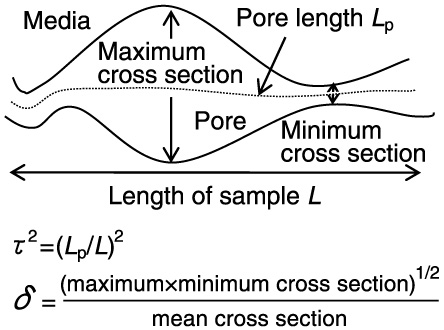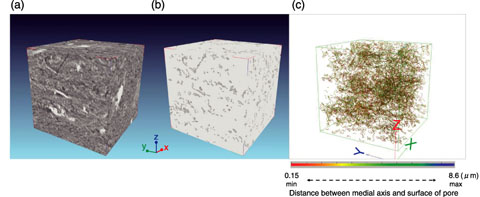
Fig.2-9 Definitions of tortuosity (τ2) and constrictivity (δ)

Fig.2-10 The porous network of the rock matrix with sub-micron-sized features is imaged and analyzed
Table 2-1 Results of image analyses and tritiated water (HTO) diffusion tests

Diffusion in a rock matrix is one of the key processes for the migration of radionuclides from high-level radioactive waste. The diffusion coefficient is an important factor in the safety assessment for deep geological disposal of high-level r adioactive waste. Diffusion in a rock matrix is affected b y the rock porosity and pore geometry. A typical diffusion model represents the geometry factor as follows: effective diffusion coefficient/(accessible porosity × diffusion coefficient in bulk water) = constrictivity/tortuosity (Fig.2-9). Empirically, the geometry factor is equal to 1/tortuosity in the case when the pore diameter is much larger than the solute diameter; however, there is no verification of the pore geometry by direct measurement. In this study, these measurements were performed by using nano X-ray computed tomography (CT) to identify the actual tortuosity and constrictivity values of siliceous mudstone samples of the Wakkanai formation at a depth of 500 m in a borehole of the Horonobe underground research center. In addition, a comparison of the results with the pore-space properties obtained from a set of tritiated water (HTO) through-diffusion tests was performed on the rock samples.
The pore structure of the rock was revealed as shown in Fig.2-10. Table 2-1 shows the results of the image analyses and HTO diffusion tests. The value of 1/tortuosity is close to the geometry factor obtained from the diffusion test. Theseresults support the empirical law in the case when the pore diameter is much larger than the solute diameter.
The values of the effective diffusion coefficient and accessible porosity obtained from HTO diffusion tests in the vertical direction are lower than those obtained in the horizontal direction. What is the origin of this result? The tortuosities obtained by image analyses are similar in both directions. This corresponds with the fact that the geometry factors evaluated from the HTO diffusion tests are similar in both directions. On the other hand, the number of start-face voxels connected to the end face in the Z-direction is lower than in other directions. This result is consistent with the results from the HTO diffusion tests, which show that the accessible porosity in the vertical direction is smaller than in the horizontal direction. This indicates that the number of connective pores and the diffusion-accessible porosity are the origins of the diffusion anisotropy. Thus, we performed a quantitative evaluation of the pore structure of the rock matrix. This method is a useful tool for the clarification of diffusion mechanisms.
The present study was the “Project for Assessment M ethodology Development of Chemical Effects on Geological Disposal System”, which was entrusted to us by the Ministry of Economy, Trade and Industry (METI).